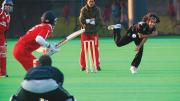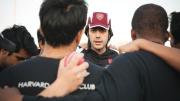Action in cricket, as in baseball, starts with a ball thrown to a batter. But in cricket, everything else happens faster: the bowler—cricket’s version of a pitcher—gets a running start, and even in recreational games the ball often heads toward the batsman, off a hop, at faster than 90 miles per hour. And it often heads right at the batsman: hitting your opponent as he guards the wicket is one of the surest ways to retire him.
“Attack, that’s the name of the game,” says Ibrahim Khan ’14, the most recent co-founder of the Harvard Cricket Club. “You need to score rapidly.” And in twenty-twenty (T-20), the scaled-down version of cricket usually played at American colleges, batsmen face fewer deliveries, meaning they’re rewarded for aggressive batting even more than in the professional version of the game.
To score runs, a batting team tries to smack the ball past the 11 players on the opposing team. There are no foul balls, which means that any contact with the bat puts the ball in play, no matter whether it goes up, down, forward, or backward. A ball in flight that reaches (or goes over) a perimeter fence is good for six runs. One that reaches a fence off a bounce counts for four. For singles, doubles, and triples, both the batsman (and his partner, called the runner, who is stationed near the wicket where the bowler lets fly his delivery) must run back and forth between wickets without being thrown out.
Wickets, two sets of three bamboo sticks placed 22 yards apart, are integral to the game: not only do they mark the distance a runner has to travel—like bases, in baseball—but if the opposing team’s bowler or a fielder hits one with a ball during play, the batsman is dismissed and replaced. All of that gives the sport, and especially T-20, a much quicker pace than both its American cousin and the full-length version of the game, in which matches can stretch across days.
But the games still aren’t short. A typical T-20 match lasts three hours, structured around two halves, which are called innings. Each innings (the word is always plural) features 20 overs; each over consists of six deliveries, or pitches, by the bowler. And this is where the appellation T-20, or 20-20, comes from: 20 overs per innings, two innings per game. Scorekeeping, no surprise, is a major effort.
Khan, an applied mathematics and economics concentrator from Kirkland House, learned the game while growing up in his native Lahore, Pakistan, but had not played seriously before coming to Cambridge, owing to a cricket injury sustained as a young kid. “I got hit in the head,” he says. “Ever since then, my parents have always been a little bit paranoid about cricket.” For years, he played a recreational version, with tennis balls covered in tape and no pads, but once at Harvard, he decided to revive its cricket club—originally founded in 1868, it existed on and off until 2009—at the end of his freshman year. He recruited a group of cricket fans in the fall of 2011 (all but one regular club member grew up in a Commonwealth country, or has parents who did), and for several months they played with tennis balls indoors at the Malkin Athletic Center. This year, they graduated to the real game, with proper equipment—leg pads and helmets for batsmen, and heavier leather-covered balls—and began practicing and playing at Jordan Field, home to Harvard’s field-hockey squad.
Last spring, at a student-faculty dinner, Khan was chatting with Stephen Blyth, Ph.D. ’92, managing director of the Harvard Management Company and professor of the practice in statistics. Blyth, who grew up in Great Britain, played cricket for the club in the late 1980s. (Cricket, he says, “is the first thing that an Englishman and a Pakistani would talk about.”) Blyth soon agreed to be their faculty adviser; under American College Cricket rules, he is even allowed to participate in games if the team is short-handed. (When he plays, he’s among the club’s best batsmen.)
In competitive matches, teams often score more than 150 runs. They can score even more at Jordan Field: its narrow confines make balls hit to the left or right much more likely to reach the fence. That’s one reason why batting strategy—whether to attack with a full or checked swing, when to block a ball headed at the wicket, and whether to hit to the left or right—is a key part of the game. Likewise, a smart bowler will watch a batsman’s habits and adjust his deliveries. “You can notice where the batsman likes to go,” Khan says.
Last fall, the club won its first five games, then dropped six straight, and finished with a 6-9 overall record. But the cricketers played well at the New England regional tournament organized by American College Cricket (ACC), the sport’s national governing body, and earned a spot at the national tournament in Fort Lauderdale in March. There, playing in the only full-size cricket stadium in the country, they went up against some of the best college cricket competitors from among the 70-odd teams that play under the umbrella of the ACC. Their matches didn’t go as well as Khan had hoped—several players were exhausted after driving nonstop from Cambridge to Florida—but they rebounded to score more than 200 runs at home in the final game of the season, losing only narrowly to Dartmouth. Next school year, Khan hopes to improve on the team’s top-15 national ranking. The challenge will be getting more of the club’s two dozen casual members to show up consistently for practices and games. “Planning,” he says, “is in full force.”









